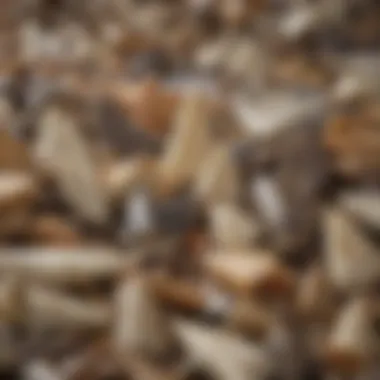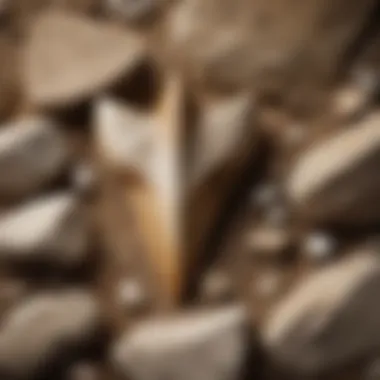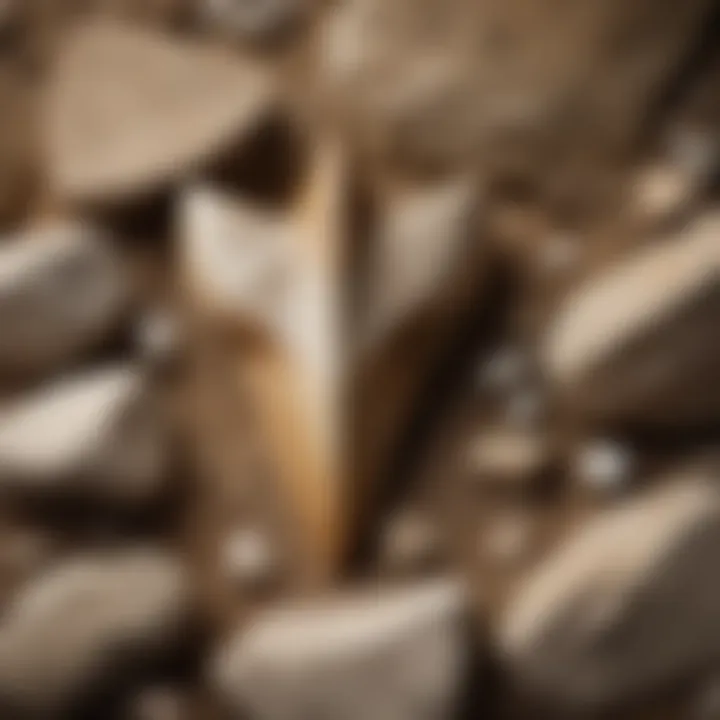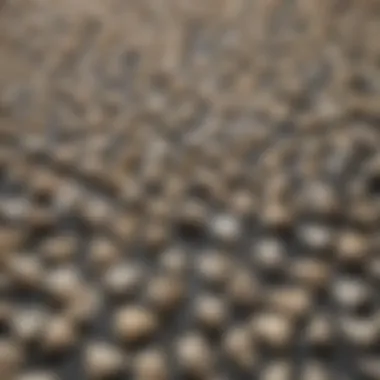Understanding Shark Teeth: A Guide for Collectors


Intro
Shark teeth have an intrinsic allure that draws many collectors and enthusiasts into the realm of natural history. As remnants of the once formidable marine predators that roamed our oceans, these fossils tell a unique story of evolution and adaptation in the aquatic world. Each tooth holds unique biological and geological attributes, making them valuable not only as collectibles but also as educational tools for understanding the life and environment of ancient sharks. This guide will equip collectors with essential knowledge about shark teeth, exploring identification methods, preservation techniques, and the ethical considerations necessary for responsible collection practices.
Featured Collectible of the Month
Overview
This month, we focus on the teeth of the Megalodon, an extinct shark that lived millions of years ago. Known scientifically as Carcharocles megalodon, its teeth can measure over seven inches in length, making them highly sought after by collectors. The size and unique characteristics of Megalodon teeth not only render them valuable but also make them a topic of fascination for those interested in paleontology and marine biology.
Historical Significance
Megalodon teeth provide insights into the prehistoric marine environment. They indicate that these massive creatures were apex predators, dominating their ecosystems. Collectors of Megalodon teeth appreciate not only the rarity of these fossils but also the stories they convey about the ancient oceans.
"The Megalodon is often described as the largest shark that ever lived, and its teeth remain a powerful symbol of the prehistoric marine world. Their sheer size and unique morphology captivate collectors and researchers alike."
Identification Techniques
Visual Characteristics
Identifying shark teeth can be both straightforward and challenging. Key visual traits to look for include:
- Shape: Shark teeth typically have a triangular shape with sharp edges, ideal for gripping and tearing flesh.
- Size: Depending on the species, teeth can vary significantly in size.
- Coloration: Many shark teeth have a coloration that ranges from black or grey to white or even brown, often influenced by their geological environment.
- Fossilization: The fossilization process can affect the texture and shine of the teeth.
Resources for Identification
For enthusiasts looking to dive deeper into identification, various resources can be invaluable:
- Field Guides: Books like The Shark Tooth Handbook provide detailed illustrations and descriptions.
- Online Forums: Websites like Reddit host discussions where collectors share insights and identification tips.
- Museums: Many natural history museums have sections dedicated to shark fossils and often offer workshops or lectures on identification techniques.
- Facebook Groups: Several groups for fossil collectors provide platforms to engage with fellow enthusiasts, fostering knowledge exchange and support.
In summary, shark teeth represent a fascinating intersection of history, biology, and collecting culture. As this guide unfolds, readers will gain a deeper understanding of what makes these fossilized remnants so significant, both personally and scientifically.
Preamble to Shark Teeth
Shark teeth are more than just objects of fascination. For collectors and enthusiasts, they represent a tangible connection to the ocean's ancient past. Understanding shark teeth involves not only recognizing their unique biological characteristics but also appreciating their significance in various contexts. This article aims to explore these dimensions, providing an extensive guide that caters to both novice collectors and seasoned enthusiasts alike.
Defining Shark Teeth
Shark teeth can be defined as the hard structures found in the mouths of sharks, made primarily of dentin and covered by enamel. Unlike human teeth, which are fixed and often lost, shark teeth are continually replaced throughout a shark's life. This adaptation allows sharks to maintain their predatory efficiency in the wild. Most species can lose thousands of teeth during their lifetimes, which makes collecting shark teeth a unique hobby. The diversity in shape, size, and arrangement of teeth across different species makes them particularly interesting for collectors.
These teeth serve a practical purpose, aiding sharks in catching and consuming prey. They can vary significantly in appearance; for instance, the teeth of the great white shark are designed for tearing flesh, while those of the whale shark are used for filter feeding on plankton. Collecting these teeth allows enthusiasts to delve into the biology and ecology of sharks, making it both a rewarding and educational experience.
Shark Teeth in Historical Context
The historical context of shark teeth is rich and diverse. Throughout history, different cultures have attached various meanings to shark teeth. In some Pacific Island cultures, they were highly valued and used as tools or in ceremonial practices. They were also sometimes worn as amulets, thought to provide protection.
Archaeological evidence suggests that prehistoric people utilized shark teeth for various purposes, including tool-making. The durability of the teeth means they often survive in the fossil record, offering insight into ancient environments and ecosystems. This connection to history and culture enhances their value as collectibles even further.
Shark teeth are not only a means to connect with the past, but they also contribute to our understanding of the evolutionary history of sharks. By studying styles and structures of these teeth in fossil records, scientists can trace the lineage of different shark species and glean information regarding their adaptations and the environments they inhabited.
Overall, the study of shark teeth presents a multifaceted view of both natural history and cultural significance, making them compelling objects for collectors.
The Biology of Sharks and Their Teeth
Understanding the biology of sharks and their teeth is essential for anyone interested in collecting and appreciating these fascinating artifacts. Shark teeth are not just mere remnants; they represent an integral part of the shark’s adaptation and survival strategies in their marine environment. Each tooth is specialized for specific feeding habits, reflecting the evolutionary pressures these animals have faced. This section explores the anatomy of shark teeth, their regeneration, and how their variations across species provide insight into their ecological niches.
Anatomy of Shark Teeth
Shark teeth possess a unique structure that makes them effective tools for predation. Unlike our teeth, which are anchored in sockets, shark teeth are attached to a soft tissue by connective material. This anatomical feature allows them to shed and replace teeth frequently throughout their lives. A typical shark can lose thousands of teeth in a lifetime, which is a direct adaptation to their feeding habits.
Key elements of shark tooth anatomy include:
- Shape: The shape varies greatly among species, influencing their dietary habits. For instance, great white sharks have serrated edges suitable for cutting through flesh, while whale sharks have flat, brush-like teeth ideal for filtering plankton.
- Size: There is significant size diversity in shark teeth, which often corresponds to the size of the shark itself. Larger species tend to have larger teeth, affecting the type of prey they can consume.
- Crown and Root Structure: The upper part of the tooth, known as the crown, differs in shape and size depending on the species' feeding strategy. The roots help anchor the tooth in the jaw, with some species having broader roots for added stability during feeding.
Regeneration and Lifespan


The capacity for regeneration is a notable aspect of shark teeth. Sharks have the ability to continuously replace their teeth throughout their lives, typically shedding a tooth every few weeks. This regenerative process ensures that they always have sharp, functional teeth to capture prey. If a tooth gets damaged or lost, a new one moves up from the rows behind, ready to take its place.
The lifespan of an individual shark tooth can vary depending on the species and environmental factors. Some species may maintain a tooth for only a few weeks, while others can keep the same teeth for months before they are replaced. The rapid turnover of teeth is beneficial for maintaining predation efficiency, especially considering the wear and tear that occurs from biting into various prey items.
Variations Across Species
Shark teeth are incredibly diverse, reflecting the wide range of species and their adapted methods of feeding. Variations can be categorized based on multiple criteria:
- Feeding Habits: Predatory sharks like the Tiger Shark have teeth designed for gripping and cutting, while filter-feeding species, such as the Hammerhead, have differently shaped teeth optimized for their diet of small fishes and cephalopods.
- Environmental Adaptations: Sharks that inhabit sandy ocean floors may possess flat, broad teeth to help them crush prey like crustaceans, while those dwelling in open water often have sharper, pointed teeth to easily slice through slippery fish.
- Evolutionary History: The fossil record provides insight into how tooth shapes have evolved over millions of years in response to changing diets and environments. For example, ancient shark species showcase a variety of tooth designs that reveal unique adaptations to their respective ecological niches.
"The diversity of shark teeth is a remarkable reflection of evolutionary advantage, showcasing the myriad feeding strategies that have emerged over time."
Understanding these anatomical details, regenerative capabilities, and species variations allows collectors and enthusiasts to appreciate the complexity behind shark teeth. Recognizing the underlying biological principles improves identification skills and informs ethical collection practices, making the pursuit of shark teeth rewarding on multiple levels.
Types of Shark Teeth
Understanding the different types of shark teeth is essential for collectors. Each tooth not only offers a glimpse into the specific species of shark but also enriches the collector's experience. The diversity in shape, size, and structure of shark teeth reflects the varied diets and habitats of these ancient creatures. Knowing the specifics can enhance one's ability to identify and appreciate these fossils more deeply.
Distinct Features of Various Species
Shark teeth come in many forms, shaped by evolutionary adaptations. For example, the teeth of a Great White shark are triangular and serrated, optimizing them for slicing through flesh. In contrast, the teeth of a Hammerhead shark are more flattened, suitable for gripping slippery prey like squid.
- Great White Shark (Carcharodon carcharias): Sharp, serrated teeth designed for cutting.
- Tiger Shark (Galeocerdo cuvier): Jagged edges that help it consume a variety of foods, from fish to sea turtles.
- Bull Shark (Carcharhinus leucas): Broad, flat teeth for crushing prey, reflecting a more opportunistic feeding style.
These distinct dental structures not only speak to hunting strategies but also can be indicators of age and health within shark populations. As a collector, recognizing these features paves the way for successful identification and can inform the story behind each tooth.
Commonly Collected Species
In the realm of shark tooth collecting, certain species are particularly sought after due to their unique characteristics or historical significance. These include:
- Mako Shark: Their sharp, slender teeth are often found and collected for their aesthetic appeal.
- Megalodon: Arguably the most famous prehistoric shark, Megalodon teeth can reach sizes of 7 inches or more and are highly valued.
- Sand Tiger Shark (Carcharias taurus): Known for their unique, dagger-like teeth. These are relatively common in fossil beds.
Collectors often gravitate towards these species due to their notoriety and the fascinating stories embedded in their evolution. This trend also highlights the importance of conservation, as the popularity can sometimes drive demand for ethically sourced specimens.
Rare and Unique Specimens
A more niche interest among collectors lies in rare and unique teeth. These specimens can represent unusual species or irregularities found within a known species. Some of the most fascinating include:
- Extinct Species Teeth: Teeth from species such as the Helicoprion, which had a spiral tooth structure.
- Venus Shark (Hydrurga leptonyx): Rarely found and often misidentified, it features a distinctive series of blade-like edges.
- Pathological Teeth: Teeth displaying unusual growths or deformities offer a glimpse into the shark's life history and health.
Collecting these teeth not only satiates a collector's curiosity but can also contribute to scientific knowledge through citizen science.
"Every shark tooth tells a story, serving as a tiny window into the past, holding secrets of survival, adaptation, and evolution."
Overall, the variety within shark teeth enriches the collecting experience. Whether seeking common specimens or unique anomalies, each tooth collected adds to a greater understanding of these ancient predators.
Identifying Shark Teeth
Identifying shark teeth is a pivotal element of understanding their value and significance in the collecting community. Enthusiasts need the ability to differentiate between various species and forms, as this shapes the worth and historical importance of each specimen. Accurate identification not only enhances the collector's experience but also contributes to scientific knowledge regarding past shark species and environmental changes. Without proper identification, collectors may overlook key attributes that could elevate a basic find into a noteworthy exhibit in their collection.
Tools for Identification
Tools for identification vary widely but play a critical role in discernment. They include:
- Magnifying glass or jeweler's loupe: Essential for examining fine details, such as serration patterns and wear levels. Many novice collectors underestimate the value of this inexpensive tool.
- Digital scale: Weight can offer insight into the size category of the specimen. Understanding the weight can also assist in estimating the species.
- Reference books and field guides: These resources provide comprehensive descriptions, illustrations, and comparisons of different shark teeth. Books such as "Shark Teeth of the World" are particularly useful.
- Online databases and forums: Websites and communities such as Reddit and specialized groups help in sharing knowledge and images for comparison purposes.
Each of these tools helps sharpen the collector's ability to identify and appreciate shark teeth.
Key Characteristics to Recognize
Recognizing key characteristics is crucial for successful identification. Certain features stand out and can help collectors determine the species. Key characteristics include:
- Size and shape: Different shark species exhibit distinct variations in size and overall tooth shape.
- Serration patterns: Tooth edges can be smooth or serrated. This detail often indicates a predator's feeding habits, providing insight into its ecological niche.
- Color and sheen: The color can vary significantly among species due to environmental factors and fossilization processes, leading to aesthetic value as well.
- Root structure: Examining the roots provides clues about the shark species and its habitat. The shape and size of the roots can distinguish between similar looking teeth.
Recognizing these characteristics can aid in narrowing down options when identifying a new specimen.


Resources for Identification
Access to proper resources greatly enhances the identification process. Some recommended resources include:
- Wikipedia: Great for basic information about types and history of sharks.
- Britannica: Offers detailed discussions on shark biology and ecology, useful for understanding tooth characteristics.
- Collector forums on Reddit: A venue to ask questions and compare specimens with fellow enthusiasts.
- Shark tooth identification apps: Certain mobile applications allow users to take photos and identify species on-the-go with decent accuracy.
Utilizing a combination of these resources ensures that collectors have a solid foundation for identifying shark teeth effectively, further deepening their appreciation for these unique fossils.
Collecting Shark Teeth
Collecting shark teeth serves as a bridge between natural history and personal passion. For enthusiasts, these unique fossils represent not only a tangible connection to prehistoric marine life but also an opportunity to engage with science and culture. The act of collecting shark teeth encourages a deeper understanding of biological evolution and geological processes. It opens pathways for education, community building, and environmental awareness.
Best Locations for Collecting
Identifying prime locations for collecting can greatly enhance the collector's experience. Several coastal areas are well-known for yielding a rich variety of shark teeth. Here are some renowned regions:
- Venice Beach, Florida: Known as the "Shark Tooth Capital of the World," Venice Beach offers extensive opportunities. Erosion exposes long-buried fossils, making it an ideal hunting ground for collectors of all levels.
- Cherry Point, North Carolina: This site is recognized for its Miocene-age deposits, attracting collectors in search of fossilized shark teeth. The sandy beach makes the treasure hunt accessible and enjoyable.
- Calvert Cliffs, Maryland: The cliffs offer marine fossils from up to 20 million years ago. A variety of species can be found here, including the teeth of the megatooth shark.
- South Carolina's Edisto Beach: This location is less commercialized, providing a serene environment to search for shark teeth washed up along the shore.
Each of these locations has distinct geological features and history that contribute to the types of shark teeth one might find. Researching local regulations and conditions can enhance your chances of a successful hunt.
Legal and Ethical Considerations
Engaging in the collection of shark teeth must be balanced with a sense of responsibility. Laws vary by region, so it's essential to familiarize yourself with local regulations governing fossil collection. Some areas may have restrictions that protect endangered species or sensitive habitats. Ignoring these guidelines can lead to penalties and harm to ecosystems.
Ethical collecting practices emphasize sustainability and respect for nature. Here are key points to consider:
- Avoid collecting in protected areas: Many parks and reserves prohibit fossil removal.
- Limit your take: Collect only what you need for your personal collection. This ensures others can also enjoy the hunt.
- Educate others: Share your knowledge about responsible collecting to foster a community of mindful enthusiasts.
- Report violations: If you witness harmful practices, consider reporting them to local authorities.
The joy of collecting shark teeth must be accompanied by an understanding of the ecological and legal landscape. As enthusiasts, we play a role in preserving these natural resources for future generations.
Preservation Techniques
In the realm of shark tooth collecting, preservation techniques play a crucial role in maintaining the integrity of the specimens. As these intriguing fossils can date back millions of years, it is vital to ensure that they remain in good condition for both aesthetic appreciation and scientific inquiry.
Proper cleaning and care are essential first steps in the preservation process. Many collectors may encounter shark teeth that are coated in sand, dirt, or marine growth. When cleaning these teeth, gentle approaches are encouraged. Using a mild soap solution along with a soft brush can help remove unwanted debris. It is important to avoid harsh chemicals that could degrade the fossil material.
After cleaning, drying is equally significant. Placing the teeth on a soft cloth in a well-ventilated area is advisable. Avoid sunlight, as prolonged exposure can cause discoloration or cracking. Allowing the teeth to air dry completely prevents moisture retention, which can lead to organic deterioration.
Cleaning and Caring for Shark Teeth
Once you have cleaned your shark teeth, caring for them becomes a primary focus. Regular inspection is recommended. This helps to identify any signs of damage or decay early. Keep the teeth away from extreme temperatures and humidity, as these factors can alter their structure over time.
Applying a small amount of microcrystalline wax can enhance the aesthetic appeal of your specimens. This wax can protect against dust accumulation and physical abrasion. Using this method will also add a subtle sheen to the teeth, making them more visually appealing.
Tip: Always handle shark teeth by their edges or using gloves to prevent oil transfer from your fingers, which may stain or damage the surface.
Storage Solutions for Collections
Storage solutions are vital for the long-term preservation of shark teeth. The choice of container can impact how well your collection fares over time. Ideally, specimens should be stored in acid-free boxes or containers to prevent chemical reactions that could harm the teeth.
Using trays with compartments can help prevent contact between individual teeth, minimizing the risk of abrasion. Labels should be included, documenting the species and collection location, which can add value and knowledge to your collection.
Humidity control is another consideration. Silica gel packets can be placed within storage containers to absorb excess moisture. This helps maintain an appropriate environment for preservation.
Finally, consider the display options carefully. If showcasing your collection, ensure that the display materials are UV-resistant and non-toxic. This ensures that your shark teeth remain safe from harmful light exposure and contaminants.
In summary, effective preservation techniques involving careful cleaning, regular inspection, and appropriate storage solutions will enhance the longevity and integrity of a shark tooth collection, making it a rewarding endeavor both personally and scientifically.
The Paleontological Significance of Shark Teeth
Shark teeth hold a significant position in paleontology, serving as vital indicators of biological and ecological history. These simple, yet fascinating fossils provide insight into the evolutionary past of sharks and their adaptations over millions of years. Their structure, shape, and distribution tell a story that transcends the confines of time. Understanding this significance enriches the experience of collectors and enthusiasts alike, allowing them to appreciate their finds beyond mere aesthetics.
Shark Teeth in Fossil Records
Shark teeth are abundant in the fossil record, primarily due to their mineralized composition. Unlike many vertebrates, sharks lack bones; their skeletons are made of cartilage, which doesn’t fossilize well. However, their teeth, which are made of a hard substance called enameloid, are frequently preserved in sedimentary rocks. This preservation offers a wealth of information about ancient marine environments and species diversity. Fossilized shark teeth can range from mere fragments to nearly complete specimens, showcasing a variety of shapes and sizes.


Studying these fossils can reveal:
- Temporal Distribution: Certain species of sharks thrived during specific geological periods. For instance, the teeth of the Megalodon contribute to our understanding of this ancient predator's existence during the Cenozoic Era.
- Paleobiogeography: The location where certain shark teeth are found helps in mapping ancient oceans and understanding past climates and environmental conditions. For example, finding warm-water shark teeth in cooler regions indicates historical shifts in marine habitats.
- Extinction Events: Shark teeth can be indicators of mass extinction events and their aftermaths, helping researchers analyze how these extinctions affected marine ecosystems.
The diversity of shark teeth found in various fossil layers enhances our knowledge of biological adaptation and extinction, showcasing the resilience of these remarkable creatures over time.
Contributions to Understanding Shark Evolution
The evolution of sharks is a complex narrative that spans hundreds of millions of years. Shark teeth play a crucial role in tracing this evolutionary path. By examining morphological changes in teeth, scientists can infer dietary habits and ecological roles of ancient sharks. The modifications in tooth structure often reflect changes in prey availability and environmental adaptations.
By categorizing shark teeth from various time periods, researchers can identify:
- Phylogenetic Relationships: The physical variations in teeth offer clues to the genetic relationships among different shark species. This helps to construct evolutionary trees that can illustrate how species are related.
- Functional Adaptations: Sharp, serrated teeth suggest a diet of flesh, while flat, grinder-like teeth indicate a preference for mollusks or crustaceans. Such insights inform how sharks have evolved alongside their prey.
- Extinct Species Contributions: Analyzing the teeth of both extinct and extant shark species provides a broader understanding of biodiversity throughout earth's history, revealing how environmental changes shaped the evolution of sharks.
Understanding the paleontological significance of shark teeth continues to be a valuable pursuit for collectors and researchers. It helps in forming a more comprehensive picture of marine life throughout different geological periods and encourages careful consideration of ethical collecting practices. This respect for the past ultimately fosters a deeper appreciation of the role sharks have played in shaping our oceans.
Shark Teeth in Culture
Shark teeth hold significant cultural value across various societies and have been represented in folklore, art, and jewelry. They symbolize strength, resilience, and a connection to nature. This examination of shark teeth in culture sheds light on how they are perceived, used, and revered in different contexts.
Symbolism and Myths Surrounding Shark Teeth
In many cultures, shark teeth symbolize power and protection. They are often viewed as talismans with the ability to ward off danger. For example, in Indigenous Hawaiian culture, shark teeth are considered sacred and are associated with spiritual strength. They are also linked to the god Kanaloa, who represents the ocean and its wildlife.
Myths surrounding sharks often convey respect and fear, underscoring their position at the top of the marine food chain. Some legends depict sharks as ancestors or deities, emphasizing their importance in folklore. Such narratives enhance the mystique surrounding shark teeth, making them more than mere fossils for collectors; they represent a cultural heritage and a connection to the ocean.
Art and Jewelry Featuring Shark Teeth
Shark teeth also serve as a popular medium in art and jewelry. Artists and jewelers incorporate them into various pieces, showcasing their natural beauty. Jewelry made from shark teeth can vary from simple necklaces to intricate earrings. These creations often appeal to a sense of adventure and a fascination with marine life.
The aesthetic appeal of shark teeth lies in their unique shapes and textures. Each tooth tells a story of the shark’s life and its evolutionary journey. Collectors often seek out carefully crafted items that highlight these features. Moreover, the use of shark teeth in jewelry also carries an environmental message. By transforming a natural artifact into wearable art, artists draw attention to the fragility of marine ecosystems.
Collecting shark teeth helps foster awareness of environmental issues while preserving their unique beauty.
Technological Advances in Shark Tooth Research
Advancements in technology have revolutionized the study of shark teeth, enabling researchers and enthusiasts alike to delve deeper into their morphology, biology, and history. This section focuses on two primary areas: microscopy and genomic studies, both of which offer invaluable insights into the world of sharks.
Microscopy and Imaging Techniques
Microscopy plays a crucial role in examining shark teeth at the microscopic level. Advanced imaging techniques, like scanning electron microscopy (SEM), allow researchers to capture intricate details of tooth structures which are otherwise not visible to the naked eye. These detailed images can reveal the surface texture, wear patterns, and growth lines on shark teeth, enhancing our understanding of their development and function.
- Surface Analysis: SEM can show the abrasive wear on teeth, helping scientists understand dietary habits and ecological roles of various shark species.
- Comparative Studies: Microscopy aids in comparing teeth across species. This helps unearth evolutionary trends and adaptations in the shark's diet and environment over millions of years.
Additionally, computed tomography (CT) scanning offers a non-destructive method to investigate the internal structure of shark teeth. This technique allows for 3D imaging, making it easier to create accurate models for further study.
Genomic Studies on Sharks
Genomic research has provided profound insights into the biology of sharks, specifically concerning their teeth. This field of study examines the genetic factors that influence tooth formation and regeneration. Understanding the genome of sharks can reveal how they develop such specialized teeth suited for various feeding methods.
- Genetic Sequencing: Researchers are now able to sequence shark DNA to understand the genes responsible for tooth development. Mutations and variations in these genes could explain why certain species have unique tooth characteristics.
- Evolutionary Biology: Genomic studies help in tracing the evolutionary history of sharks, showing how specific traits have developed over time. Such knowledge can inform collectors about the rarity and historical significance of certain teeth in their collections.
Both microscopy and genomic studies enhance understanding of shark teeth, offering a blend of practical applications and theoretical knowledge. The technological advancements not only aid in studies but also enhance the appreciation of shark fossils among collectors and enthusiasts. As these technologies evolve, they promise to disclose new aspects of shark biology and evolution, making them essential in the ongoing research concerning these ancient creatures.
The End
The conclusion of this article encapsulates the multifaceted nature of shark teeth, focusing on their significance not just as collectibles but also as vital components of biological and geological studies. Shark teeth provide insight into the evolutionary history of sharks and their adaptations over millions of years. Understanding their importance can enhance the appreciation of these unique fossils, making them more than mere objects of fascination for collectors.
The Future of Shark Tooth Collecting
The future of shark tooth collecting is characterized by growing interest and evolving methodologies. As technology advances, collectors have access to better tools for identification and preservation. Digital databases and online communities are becoming invaluable resources, offering platforms for enthusiasts to share knowledge and locate rare specimens.
Moreover, environmental awareness is rising, making it essential to focus on sustainable collecting practices. The trend may lead to the establishment of guidelines regulating collection efforts, ensuring the protection of shark populations and their habitats. Additionally, educational programs can help foster a broader understanding and appreciation of the ecological significance of sharks.
Encouraging Ethical Practices in Collecting
Promoting ethical practices in shark tooth collecting is crucial for preserving both the species and their habitats. Collectors should be aware of the legal aspects surrounding collection, ensuring they comply with local regulations. Engaging with reputable sources for obtaining shark teeth can help mitigate the risk of supporting illegal trade.
Ethical collecting not only benefits the environment but also enhances the integrity of the collecting community.
Moreover, initiatives aimed at conservation can encourage collectors to contribute to shark protection efforts. Supporting organizations that focus on marine conservation can foster a sense of responsibility within the community. By prioritizing ethics, collectors can ensure that their passion does not come at the expense of the very creatures they admire.



